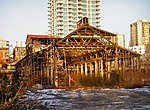Ustlawn

Ustlawn (Squamish language: Eslhá7an) is a Squamish village community located on the shores of North Vancouver. The Squamish name Eslhá7an translates as head bay, denoted what used to be the farthest out reaching bay enclave in the Burrard Inlet. Its origin as a primary village goes back to the earliest missionaries in British Columbia with the St. Paul's Catholic Church being the oldest extant church in British Columbia, and a National Historic Site of Canada. It is also home to the Eslha7an Training Center, the Stitsma Employment Center, and the So-Sah-Latch Health and Family Centre. On the shores of the village is the Mosquito Creek Marina. The official name of the Indian reserve it is situated on is Mission Indian Reserve No. 1.
Excerpt from the Wikipedia article Ustlawn (License: CC BY-SA 3.0, Authors, Images).Ustlawn
Automall Drive, North Vancouver
Geographical coordinates (GPS) Address Nearby Places Show on map
Geographical coordinates (GPS)
| Latitude | Longitude |
|---|---|
| N 49.316666666667 ° | E -123.1 ° |
Address
Morrey Mazda of the Northshore
Automall Drive 818
V7P North Vancouver
British Columbia, Canada
Open on Google Maps




